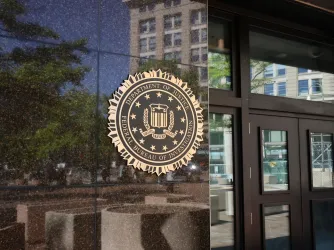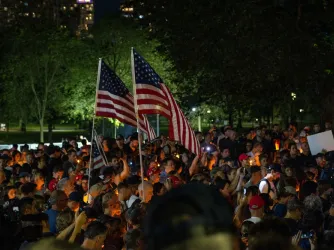Table of Contents
Smoke and Mirrors: Four Clarifications About the 'Blueprint'

Recently, National Women’s Law Center fellow Fran Faircloth criticized FIRE on the YWCA’s blog for speaking out against the federal “blueprint” for campus sexual misconduct policies set forth by the Departments of Justice and Education on May 9. In her article, titled “Pants on FIRE: Four Myths (and Truths) About the Work of the Departments of Education and Justice on Sexual Violence at Schools,” Faircloth falls into two familiar traps. She conflates physical conduct with speech and trusts colleges and universities to apply vague and overbroad rules properly, despite the decades-long history of the threat to free speech presented by collegiate speech codes and the many successful court challenges striking them down.
FIRE does not take issue with the portions of the blueprint that require universities to provide students with clearer information about the procedures and resources available to help victims of sexual assault. This is important information that universities should be providing to their student bodies. But the blueprint doesn’t just address physical conduct—it authorizes punishment for speech, too. And even unwelcome speech is protected unless it constitutes one of the narrow exceptions to the First Amendment as set forth by the U.S. Supreme Court. That is why, despite the obvious need for some of the provisions in the blueprint, other provisions have serious implications for professors’ and students’ First Amendment rights.
So let’s take a closer look at Faircloth’s claims:
Claim #1: “DOJ and OCR’s definition of sexual harassment is consistent with longstanding, well established law.”
Truth: The blueprint flatly states that sexual harassment in the university setting is “any unwelcome conduct of a sexual nature” (emphasis added), a far broader definition than that established by the Supreme Court or, in fact, required by OCR in the past.
Faircloth cites the Supreme Court’s decision in Meritor Savings Bank v. Vinson, 477 U.S. 57 (1986) for the idea that the blueprint’s definition of harassment has existed for decades. But Meritor, a case arising in the employment setting, does not establish the standard for harassment in the educational context. Despite the fact that speech is protected more broadly in the educational context than in the workplace, the blueprint’s definition of harassment is even less protective than that established by Meritor. Meritor does not hold that speech of a sexual nature is harassment merely because it is “unwelcome.” Rather, the question of whether remarks were unwelcome is one part of determining whether harassment took place; under Meritor, the behavior in question still must also “be sufficiently severe or pervasive to alter the conditions of the victim’s employment.” 477 U.S. at 67 (quotations omitted).
Furthermore, although OCR’s 2001 Revised Sexual Harassment Guidance describes sexual harassment as “unwelcome conduct of a sexual nature,” it later makes clear that not all unwelcome conduct of a sexual nature is sexual harassment—among students, conduct rises to the level of sexual harassment only when it creates a hostile environment. (“Teachers and other employees can engage in either type of harassment [quid pro quo or hostile environment harassment]. Students and third parties are not generally given responsibility over other students and, thus, generally can only engage in hostile environment harassment.”) The blueprint does not make this distinction.
The 2001 Guidance also acknowledges the Supreme Court’s standard for student-on-student harassment set forth in Davis v. Monroe County Board of Education, 526 U.S. 629, 629 (1999): targeted, discriminatory conduct that is “so severe, pervasive, and objectively offensive that it can be said to deprive the victims of access to the educational opportunities or benefits provided by the school.” While OCR at times uses different language, the Guidance notes, “[b]oth the Court’s and the Department’s definitions are contextual descriptions intended to capture the same concept—that under Title IX, the conduct must be sufficiently serious that it adversely affects a student’s ability to participate in or benefit from the school’s program.” OCR explicitly said in a 2003 “Dear Colleague” letter that the First Amendment does not allow schools to prohibit sexual harassment defined “as encompassing all offensive speech regarding sex, disability, race or other classifications.” In other words, OCR has previously required that “harassment” be something more than simply unwelcome verbal conduct of a sexual nature.
Claim #2: FIRE argues that “DOJ and OCR will prompt students to over-report harassment, because the definition of harassment is overly broad,” but this is false. Instead, “[s]tudent-to-student assault on campuses across the nation is vastly under-reported, and false reports of rape are rare.”
Truth: Here, Faircloth addresses the reporting of sexual harassment but cites only statistics relating to the reporting of sexual assault. Faircloth does not offer any statistics relating to the reporting of harassment on college campuses. And it would be difficult to accurately determine whether harassment is in fact under-reported, given that many schools already define “harassment” to include constitutionally protected speech.
Even if harassment (defined properly) is under-reported, subjecting students to investigations and potential discipline for constitutionally protected speech is not an appropriate solution. The Supreme Court’s Davisstandard is clear and precise, and speech that does not meet that standard is protected by the First Amendment. Adoption of the blueprint’s definition would create a system wherein people are encouraged to report speech that is unambiguously not harassment, and cannot be sanctioned under the First Amendment. FIRE has written before about a similar phenomenon: universities promising to investigate all incidents of “bias” and “intolerance.” Even at schools where students are not subject to official disciplinary action for their “biased” speech, these policies chill a wide range of protected expression. Likewise, adoption of the blueprint’s definition of harassment, in practice, would undoubtedly chill protected expression and is therefore not a permissible way to encourage reporting. This past July, 16 civil liberties organizations and 11 distinguished civil libertarians joined FIRE in explaining this point in a letter sent to OCR and DOJ on July 16; this coalition included the Defending Dissent Foundation, the American Booksellers Foundation for Free Expression, the Electronic Frontier Foundation, the National Coalition Against Censorship, former ACLU President Nadine Strossen, former American Association of University Professors President Cary Nelson, and many more. The American Association of University Professors’Committee on Women in the Academic Profession also expressed their concerns about the blueprint’s threat to academic freedom in a June letter to the Departments.
Claim #3: “FIRE’s claims that students would be punished for actions like giving someone a valentine card or asking someone out on a date are baseless and insulting, given that we are talking about sexual harassment and assault.”
Truth: A college’s decision to punish a student for actions like giving someone a valentine card would indeed be appalling but sadly not shocking to anyone familiar with FIRE’s work. We have seen a student found guilty of “racial harassment” for reading a book about the Ku Klux Klan, a professor threatened withcriminal charges for hanging a poster with a quote from the TV show Firefly on his door, a professor suspended for making an obvious joke about being “on a killing spree” when students were having trouble with his exam review questions, and a student barred from class for cursing outside of class time in reference to his grades. There are so many more jaw-dropping instances of everyday non-threatening speech being targeted by college administrators. It is no exaggeration to say that administrators will use a blueprint-modeled speech code to punish protected and even innocuous expression.
While this claim of Faircloth’s appears to rest mainly on her trust of administrators, it is important to note also that her citation of the wrong case law here again suggests that protections for college students’ speech are narrower than they actually are. Tinker v. Des Moines Independent Community School District(1969), the case she cites for support, involved expression by students in junior high and high school, where speech is subject to restrictions forbidden for public colleges populated by adult students.
Claim #4: The blueprint’s language “does not mean that the University has to take disciplinary action against an accused student without a proper investigation.” Because a report indicated that “reporting sexual harassment was burdensome” and confusing, “[t]he policy changes required by DOJ and OCR would help resolve these issues.” Additionally, a “preponderance of the evidence” standard “is the same standard used in civil proceedings.”
Truth: Faircloth acknowledges implicitly that the blueprint authorizes universities to take “disciplinary action against the harasser” even “prior to the completion of the Title IX and Title IV investigation/resolution”—but notes that it doesn’t have to. This is not much of a defense of the blueprint. Of course, colleges didn’t have to take any of the disciplinary actions FIRE cited above, either. In fact, they were constitutionally prohibited from taking those actions and nevertheless did so. Faircloth appears to believe that college and university administrators will simply choose not to deprive students of a fair hearing before punishment despite the fact that OCR and DOJ have explicitly authorized them to do so. Will they? Well, the University of Montana’s new policy states that “[t]he University may ... take appropriate action if it does not find discrimination or harassment that creates a hostile environment ... to prevent the creation of a hostile environment.” So Montana does in fact say that students may be subject to disciplinary action just because an administrator thinks they might at some future point engage in harassment, even if they have not yet done so.
As to Faircloth’s next point, colleges and universities can and should provide victims with resources and immediate attention, including counseling, medical care, and changes in class schedules and residential arrangements. But none of this important and necessary aid to victims requires lowering the due process protections afforded the accused student. Policies should be clear, and when discipline is at issue, bothparties should be afforded sufficient opportunity to present their testimony and other evidence. And, in accordance with our nation’s moral and legal commitment to providing the accused due process of law, the accused should be treated as innocent until proven guilty.
Faircloth is correct in noting that in civil cases, the plaintiff must prove his or her case by only a preponderance of the evidence, “even in cases where there could be criminal sanctions for the defendant’s actions, such as a civil tort action for battery, robbery, or murder.” But a college rape hearing is morecomparable to a criminal case than a civil suit. Particularly with accusations of sexual assault, a finding of guilt can derail a student’s educational career, even his or her life. Certainly sexual assault also can have a devastating effect on a victim’s life. But the question here is whether punishment can be meted out when there is insufficient evidence to show that a particular student is responsible.
FIRE’s Joe Cohn explained in an op-ed for The Chronicle of Higher Education that the due process protections offered to students facing hearings in campus judicial systems stand in stark contrast to civil trials:
While it is true that most civil cases in federal court are decided under the preponderance standard, due process requires that this low burden of proof be offset by procedural safeguards—lots of them.
For example, to ensure fairness, reliability, and constitutionality, civil trials are presided over by experienced, impartial, and legally educated judges. At either party’s request, facts are determined by a jury of one’s peers. The parties have the right to representation by counsel, and a mandatory process of “discovery” ensures that all relevant evidence will be made available if the opposing party asks for it.
And speaking of evidence, strict rules apply that exclude hearsay, evidence of prior bad acts or crimes, and other information that is either irrelevant or unreliable. Moreover, all depositions and testimonies are given under oath or affirmation, with witnesses subject to perjury charges if they intentionally lie about material issues. The list goes on and on.
So which of those procedural protections are guaranteed in college disciplinary hearings? None. The procedural safeguards used at most colleges are embarrassingly minimal.
[...]
One other important feature distinguishes civil lawsuits from campus proceedings: Civil suits can be settled for money and kept confidential. Yet students accused of sexual misconduct cannot simply settle the case for money and stay in school. Preponderance advocates should ask themselves why this is so. If the answer is that campus sexual misconduct is more like a crime (with a victim and alleged perpetrator) than a civil dispute (with a plaintiff and defendant)—as is certainly the case—then why is the preponderance standard sufficient for charges of sexual misconduct on campus?
Faircloth further states that the “preponderance of the evidence” standard is used “even in cases where there could be criminal sanctions for the defendant’s actions, such as a civil tort action for battery, robbery, or murder.” A student should not be labeled as a rapist and expelled from college because a simple majority of hearing panel members are 50.01% sure he is responsible for the alleged act. FIRE believes a “clear and convincing” standard would be more appropriate considering the interests at stake.
In short, Faircloth places too much trust in university administrators to implement policies that endanger constitutionally protected speech and makes the critical mistake of justifying restrictions on speech with facts about physical violence. Colleges and universities can and should present clear and unbiased procedures for reporting and investigating sexual assaults, and resources and support should be provided to those who need it. But the blueprint does that and more—and it is the “more” that FIRE takes issue with.
Image: University of Montana campus
Recent Articles
Get the latest free speech news and analysis from FIRE.

VICTORY: Court vindicates professor investigated for parodying university’s ‘land acknowledgment’ on syllabus

Can the government ban controversial public holiday displays?

DOJ plan to target ‘domestic terrorists’ risks chilling speech
